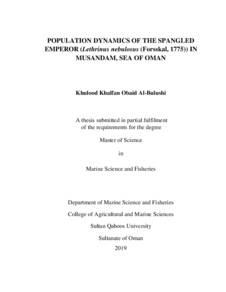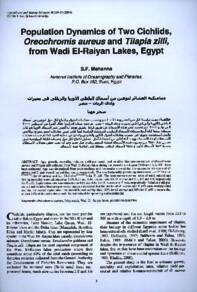وثيقة
Population dynamics of the spangled emperor (Lethrinus nebulosus (Forsskal, 1775)) in Musandam, Sea of Oman.
المعرف
Al-Bulushiyah, Khulood Khalfan Obaid (2019). Population dynamics of the spangled emperor (Lethrinus nebulosus (Forsskal, 1775)) in Musandam, Sea of Oman (Master thesis, Sultan Qaboos University, Muscat, Oman).
الناشر
Sultan Qaboos University.
ميلادي
2019
اللغة
الأنجليزية
الملخص الإنجليزي
Lethrinus nebulosus is one of the most common demersal species in Omani local
fish markets. In the Sea of Oman, no studies have addressed the biological aspects and
population dynamics of L. nebulosus, while there are records of this species being
overexploited in the Arabian Sea. Consequently, study of L. nebulosus population
dynamics is necessary to determine the status of this fishery in the Sea of Oman. The aims
of this study were to: (1) determine age, growth, recruitment, and mortality, (2) identify
the maturity stages and spawning season, and (3) determine the exploitation rate.
Biological parameters and population status of the spangled emperor (Family Lethrinidae,
Lethrinus nebulosus) in the Sea of Oman (Dibba, Musandam) were determined by
collecting monthly fish samples from local fish markets during 2016. A combination of
biological, length-frequency, age and reproductive data was used to investigate the
current status of L. nebulosus in the Sea of Oman (Musandam) and inform management
recommendations.
Fork length (FL) ranged from 14 - 61.5 cm, with an average size of 43 cm (± 0.51
S.E.) for males, and 41 cm (± 0.43 S.E.) for females. Growth parameters comparisons
showed there were no significant difference (p > 0.05) in growth between sexes. The vonBertalanffy Growth function (VBGF) parameters were an asymptotic maximum size (L∞)
of 56.76 cm, growth coefficient (k) of 0.38 year-1
, and average size at age zero (t0) of -
0.39, with a maximum age of 23 years old. The growth coefficient of 0.38 suggests that
this species is a slow-growing species, and is comparable to previous regional studies.
The sex ratio (males:females) was 1:1.75, indicating a slight female bias, as previously
observed in other studies of this species. The gonado-somatic index (GSI) highlighted a
spawning season of this species from February to April in Dibba, Musandam during 2016.
The mean length (L50) at which 50% of the population attained sexual maturity was 44
cm. The average size-at-first-capture was 42 cm which is smaller than the average sizeIV
at-first-maturity, suggesting that management policies (e.g., minimum size limits) are
needed to increase the length-at-first-capture to be higher than the average length of
sexual maturity (L50), and ensure a sustainable fishery of this species. Estimates of the
total mortality rate (Z) attained from length frequency data by catch-curve analysis, was
0.89 year-1
. The natural mortality rate (M) of 0.64 year−1
implies that the current fishing
mortality rate (F) was 0.26 year−1
, which is lower than recommended reference points F0.1
(0.30 year−1
) and Fmax (0.35 year−1
). The relative spawner-biomass-per-recruit was
estimated to be 34% of unexploited levels at the current fishing mortality rate.
In conclusion, these findings suggest that the spangled emperor stock in
Musandam, Sea of Oman, is currently not overexploited, but that the stock could be
experiencing recruitment overfishing. Consequently, management policies, such as
minimum size limits, spawning season catch bans, marine protected areas, and using highselectivity fishing gear are needed imminently to ensure the future sustainability of this
fishery under increasing pressures in the future.
المجموعة
URL المصدر
الملخص العربي
تعتبر سمكة الشعري )خودير( )nebulosus Lethrinus )أحد أنواع الاسماك القاعية الاكثر شيو ًعا في الاسواق المحلية العمانية. وفي هذه الدراسة تم تحديد العوامل البيولوجية وحالة المخزون لسمكة الشعري )الخودير( في بحر عمان )دبا -مسندم( من خالل جمع عينات شهريه لمدة سنة خالل عام 2016م، حيث تم استخدام مزيج من البيانات البيولوجية والتناسلية وبيانات الاطوال والاعمار، وتجدر الاشارة هنا إلى عدم وجود دراسات سابقة في هذا الشأن وعن هذه السمكة في بحر عمان، في حين أن بعض الدراسات أشارت بأن هذا النوع قد تم استغالله بشكل مفرط في بحر العرب. لذلك فإن دراسة الديناميكية السكانية لهذا النوع في بحر عمان ضرورية لفهم حالة هذا المصيد. تهدف هذه الدراسة الى تحديد عمر، ومعدل نمو، ونسبة نفوق سمكة الشعري، كذلك تحديد مراحل النضج وموسم التفريخ، وتحديد معدل استغالل مخزون السمكي لهذا النوع. تراوح الطول الشوكي )FL )لسمكة الشعري بين 14 و5.61 سم، بمتوسط حجم 43 سم (.E.S 51.0(± للذكور، و41 سم (.E.S 43.0 (± لإلناث، وأظهرت مقارنات معايير النمو عدم وجود اختالف كبير )05.0> p ) في النمو بين الجنسين. وقد أشارت معايير الدالة (VBGF (Growth Bertalanffy-von إلى أن أقصى طول افتراضي )∞L )بلغ 76.56 سم، ومعيار النمو )K )بلغ 38.0/ سنة، ومتوسط الحجم عند عمر صفر )t0 )كان 39.0- سنة، وتمتد حياة الشعري الى حوالي 23 سنة. ويشير معيار النمو )38.0 )أن هذا النوع بطيء النمو، أما الحد الاقصى للحجم الافتراضي فيبين أن هذا النوع من الانواع القاعية الكبيرة، وقد تبين توافق هذه النتائج مع الدراسات الاقليمية السابقة. وفيما يتعلق بالنسبة والتناسب بين الجنسين )ذكور: إناث( 1 :75.1 ،فقد بينت الدراسة بأن هناك تحيز طفيف لإلناث في المخزون السمكي، الامر الذي يتوافق مع بعض الدراسات الاخرى. أظهر مؤشر الغدد التناسلية (GSI(الى أن موسم التفريخ لهذا النوع في دبا – مسندم خالل عام 2016م يمتد من شهر فبراير الى شهر ابريل. وكان متوسط الطول )L50 )الذي بلغ فيه 50 %من إجمالي مجموعة الاسماك النضج الجنسي 44 سم. وأن متوسط أحجام أصغر الاسماك اصطيادا كان 42 سم وهو أصغر من الحجم عند أول نضج جنسي، مما يشير إلى أن سياسات الادارة )على سبيل المثال، حدود الحد الادنى للحجم( ضرورية لزيادة طول الاسماك الصغيرة المصطادة ليكون أعلى من طول النضج الجنسي لضمان استدامة مصيد هذا النوع. بلغ معدل الوفيات الاجمالي )Z )89.0/سنة، والذي تم تحديده من بيانات الاطوال باستخدام منحى المصيد )curve catch .)وأشار معدل النفوق الطبيعي )M )البالغ 64.0/ سنة الى أن معدل النفوق الناتج عن الصيد )F )26.0 /سنة أقل من النقاط المرجعية 1.F0( 30.0/سنة(، و Fmax )35.0 /سنة(. وقد قدرت الكتلة الحيوية النسبية لكل جيل بنسبة 34 ٪من المستوى غير المستغل في معدل الوفيات الحالي.تشير هذه النتائج بشكل عام إلى أن سمكة الشعري في بحر عمان )مسندم( لم يتم استغاللها بشكل مفرط في الوقت الراهن، لكن توجد احتمالية لحدوث صيد مفرط لألجيال. ونتيجة لذلك، فإن هناك حاجة ملحة الى سياسات إدارية كحظر الصيد خالل موسم التفريخ، تحديد منطقة محمية بحريه، وإستخدام معدات صيد عالية الانتقائية وذلك لضمان الاستدامة المستقبلية لهذه المصايد في ظل الضغوطات المتزايدة على هذا النوع في السنوات القادمة
قالب العنصر
الرسائل والأطروحات الجامعية


